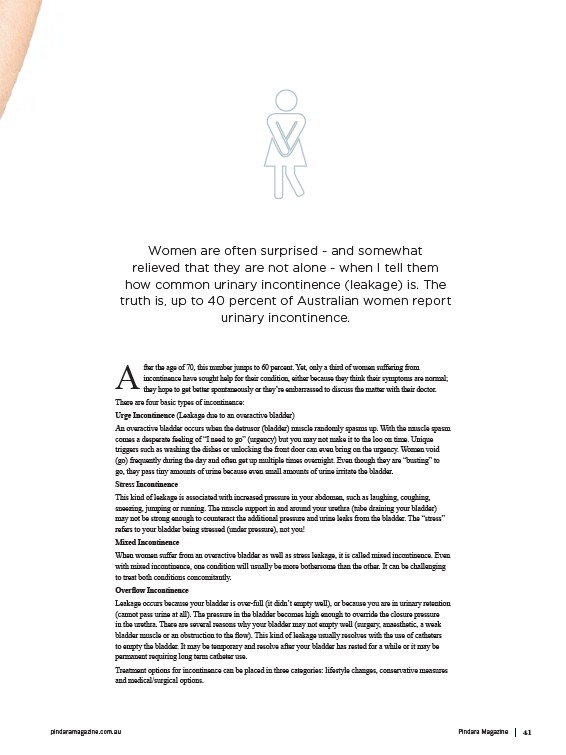
Pindara Magazine 41
Women are often surprised - and somewhat
relieved that they are not alone - when I tell them
how common urinary incontinence (leakage) is. The
truth is, up to 40 percent of Australian women report
urinary incontinence.
fter the age of 70, this number jumps to 60 percent. Yet, only a third of women suffering from
incontinence have sought help for their condition, either because they think their symptoms are normal;
they hope to get better spontaneously or they’re embarrassed to discuss the matter with their doctor.
A
There are four basic types of incontinence:
Urge Incontinence (Leakage due to an overactive bladder)
An overactive bladder occurs when the detrusor (bladder) muscle randomly spasms up. With the muscle spasm
comes a desperate feeling of “I need to go” (urgency) but you may not make it to the loo on time. Unique
triggers such as washing the dishes or unlocking the front door can even bring on the urgency. Women void
(go) frequently during the day and often get up multiple times overnight. Even though they are “busting” to
go, they pass tiny amounts of urine because even small amounts of urine irritate the bladder.
Stress Incontinence
This kind of leakage is associated with increased pressure in your abdomen, such as laughing, coughing,
sneezing, jumping or running. The muscle support in and around your urethra (tube draining your bladder)
may not be strong enough to counteract the additional pressure and urine leaks from the bladder. The “stress”
refers to your bladder being stressed (under pressure), not you!
Mixed Incontinence
When women suffer from an overactive bladder as well as stress leakage, it is called mixed incontinence. Even
with mixed incontinence, one condition will usually be more bothersome than the other. It can be challenging
to treat both conditions concomitantly.
Overflow Incontinence
Leakage occurs because your bladder is over-full (it didn’t empty well), or because you are in urinary retention
(cannot pass urine at all). The pressure in the bladder becomes high enough to override the closure pressure
in the urethra. There are several reasons why your bladder may not empty well (surgery, anaesthetic, a weak
bladder muscle or an obstruction to the flow). This kind of leakage usually resolves with the use of catheters
to empty the bladder. It may be temporary and resolve after your bladder has rested for a while or it may be
permanent requiring long term catheter use.
Treatment options for incontinence can be placed in three categories: lifestyle changes, conservative measures
and medical/surgical options.
pindaramagazine.com.au